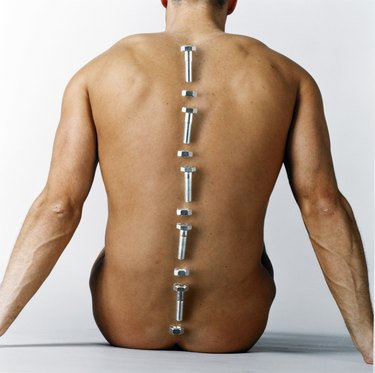
Schmorl's nodes, also known as Schmorl's nodes syndrome, is a deformity of the vertebrae. The condition can occur through sudden or repeated trauma to the back or as vertebrae degenerate over time. Certain exercises may help ease the condition. These exercises should be undertaken only under the supervision of your doctor or physical therapist.
Anatomy
Video of the Day
The vertebrae are small, individual bones connected to each other, which run down the middle of your back and protect your spinal column. A disc sits between each bone of the vertebrae as a shock absorber to cushion jolting movements. Schmorl's nodes occur when discs break through the vertebral wall, enabling the soft tissue within the discs to penetrate between the vertebrae. Schmorl's nodes are generally found in the middle and lower spine.
Video of the Day
Considerations
Schmorl's nodes may also occur due to an abnormal curvature of the spine such as scoliosis or kyphosis. Scoliosis may be congenital or caused by disease. Kyphosis has various possible causes, including a poor posture over a prolonged period; Scheuermann's disease, in which different parts of the vertebrae grow at different rates; or fractures in the vertebrae caused by a weakening of the bones, often due to osteoporosis.
Function
Exercises to combat Schmorl's nodes must be supervised by your doctor, chiropractor or physical therapist. The exercises can stretch and relax tight muscles from the abnormal curvature of your spine, improve your posture and strengthen your abdominal muscles. Strong abdominal muscles help maintain correct posture.
Back Exercises
Sit on an exercise ball with your feet and knees together and breathe evenly with your diaphragm. Your stomach should inflate when you breathe in and deflate when you breathe out. Keep your knees bent and raise your right leg and left arm simultaneously. Lower both slowly and repeat with your left leg and right arm. Do not shift your hips or let the ball move as you perform the exercise. Repeat for the number of repetitions recommended by your therapist.
Maintain your position on the exercise ball and raise your heels from the floor. Breathe with your diaphragm and lift your arms out to your side. Perform a quarter turn to your left, return to your starting position, then turn to your right. Do the prescribed number of repetitions. Do not shift your hips or let the ball move.
Abdominal and Core Exercises
Lie flat on your back with your legs bent and feet flat on the floor. Keep your arms by your side. Tighten your abdominal and butt muscles, and gently lift your body as a single unit without tilting your pelvis. Lower your body and repeat for the number of repetitions recommended by your therapist.
Perform abdominal curls. Maintain your position on the floor and place your arms across your chest. Contract your abdominal muscles and gently lift your shoulders. Lower your shoulders and repeat for the prescribed number of repetitions. Exhale as you raise your shoulders.
Posture Balancing
Stand with your back against a wall with your feet 12 to 14 inches from the wall. Raise your arms sideways at 30 degrees with your palms facing outward. Try to touch the wall with your hips, lower back, middle back, shoulders and head while breathing with your diaphragm. Relax your neck muscles, and do not force your head back against the wall. Slide your arms up against the wall until you are unable to maintain bodily contact with the wall. Relax, step away from the wall, and repeat.